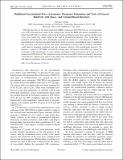Multiband Gravitational-Wave Astronomy: Parameter Estimation and Tests of General Relativity with Space- and Ground-Based Detectors
Author(s)
Vitale, Salvatore
DownloadPhysRevLett.117.051102.pdf (683.0Kb)
PUBLISHER_POLICY
Publisher Policy
Article is made available in accordance with the publisher's policy and may be subject to US copyright law. Please refer to the publisher's site for terms of use.
Terms of use
Metadata
Show full item recordAbstract
With the discovery of the binary-black-hole (BBH) coalescence GW150914 the era of gravitational-wave (GW) astronomy has started. It has recently been shown that BBH with masses comparable to or higher than GW150914 would be visible in the Evolved Laser Interferometer Space Antenna (eLISA) band a few years before they finally merge in the band of ground-based detectors. This would allow for premerger electromagnetic alerts, dramatically increasing the chances of a joint detection, if BBHs are indeed luminous in the electromagnetic band. In this Letter we explore a quite different aspect of multiband GW astronomy, and verify if, and to what extent, measurement of masses and sky position with eLISA could improve parameter estimation and tests of general relativity with ground-based detectors. We generate a catalog of 200 BBHs and find that having prior information from eLISA can reduce the uncertainty in the measurement of source distance and primary black hole spin by up to factor of 2 in ground-based GW detectors. The component masses estimate from eLISA will not be refined by the ground based detectors, whereas joint analysis will yield precise characterization of the newly formed black hole and improve consistency tests of general relativity.
Date issued
2016-07Department
LIGO (Observatory : Massachusetts Institute of Technology)Journal
Physical Review Letters
Publisher
American Physical Society
Citation
Vitale, Salvatore. "Multiband Gravitational-Wave Astronomy: Parameter Estimation and Tests of General Relativity with Space- and Ground-Based Detectors." Physical Review Letters 117, 051102 (July 2016): 1-5 © 2016 American Physical Society
Version: Final published version
ISSN
0031-9007
1079-7114